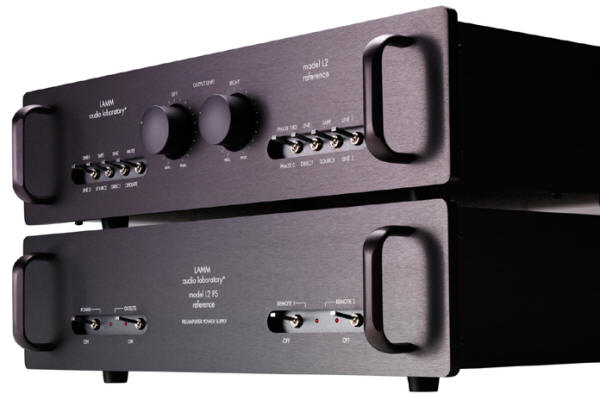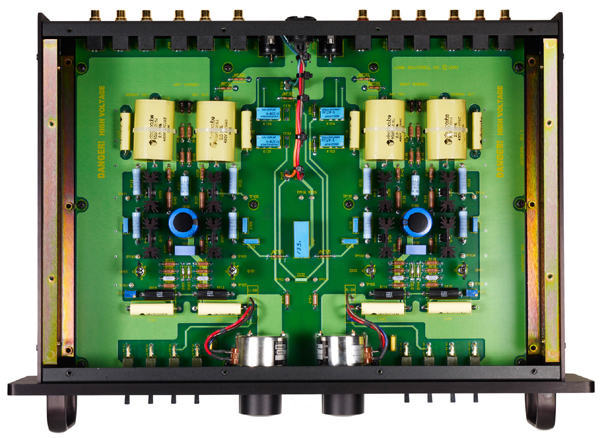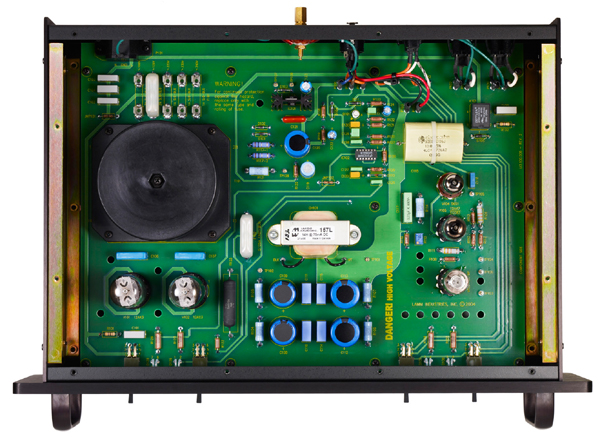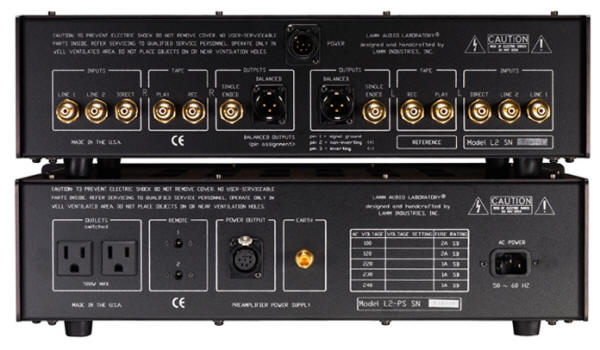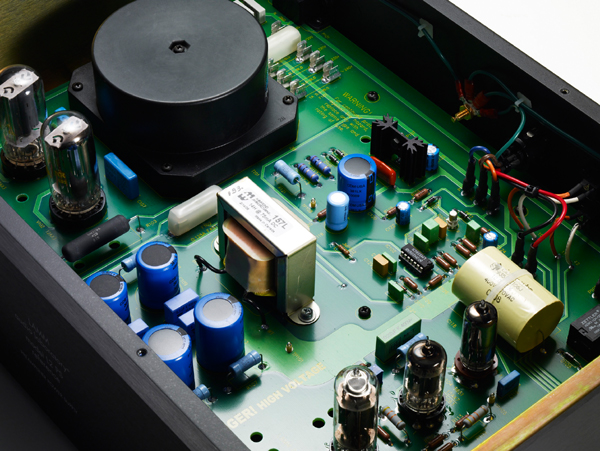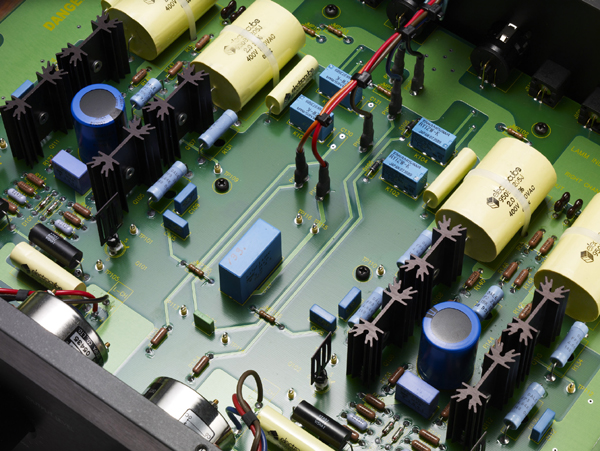|
You are reading the older HTML site
Positive Feedback ISSUE 66
Impressions: The Lamm L2 Preamplifier
[All images courtesy of Lamm Industries, Inc.; cartoon by Bruce Walker]
The Return of Lamm to Portlandia… What is it that makes a preamp rise above the run-of-the-mill in fine audio? How can an audio designer go over ground that is well known and still come up with something distinctly his own? Good questions. Advances in fine audio electronics are happening all the time, though the classic designs remain just that. It used to be that preamps in the $15,000 range were relatively rare. That's not so true an more; this ava raris has lost some of its raris. You can certainly spend $25,000 (and on up) for no-holds-barred preamps, and have more than one or two or three to look at. From that standpoint, the Lamm L2 is definitely an investment, but is not in the upper end of ultra-expensive preamps. I've known the work of Vladimir Lamm for many years now. In fact, I've reviewed the Lamm M1.2 monoblocks (which I own… tells you what I think of them), the LP2 phono amp, and the LL2 preamp (now replaced by the upgraded model, the LL2.1), the single-box kid brother of the L2. The arrival of the L2 was therefore the fourth in the product line of Lamm electronics for my evaluation. I've handed out some Brutus Awards to Lamm over the years, all very well deserved, and so I didn't think that there was much risk of disappointment. I think that I have acquired a very good feel for the sonics of Lamm gear over the years, and so was looking forward to hearing the L2. The good folks at Lamm were willing to send along a sample, and so we were good. When I said that "the classic designs remain just that," it would apply to the L2. It isn't new to the marketplace, having been around for over twelve years now, but one of the great things about Lamm gear is that it doesn't change models every season, nor do its designs float in and out of style. It appears that Vladimir values doing the work right, and then staying the course with his product line. Given the fact that his creative work has been so very sound (no pun intended), it's no surprise that his designs are well on the way to becoming audio classics. Trendy, no. Enduring, yes. Unfortunately, this review got tangled up in some very large full-system review projects, my very heavy teaching schedule at several universities, and some new enterprises here…not to mention items like the DSD Revolution and RTR Movement that I've been documenting. This means that it's overdue…this long-developing review is the remedy for that problem. Product Description The Lamm L2 is a two-box preamp, single-ended, with a separate power supply component. The design is a hybrid, employing both tubes and solid state devices to do the job.
The Lamm L2 preamplifier section, top view The preamp section is solid state, running pure Class A, with "no overall feedback at any stage." I can confirm that the preamp does run somewhat warm when powered up…it definitely feels like a pure Class A device. Lamm uses high-quality very linear MOSFETs in the circuits of the L2. Their parts description indicates the commitment to excellence that they've made in their work, as described on their Web site (http://www.lammindustries.com/PRODUCTS/L2descr.html): Each preamplifier is carefully hand-crafted with matched components of the highest quality, some of which include military graded low noise DALE metal film resistors; unique TKD stepped potentiometers (41 detents); PRC wire wound resistors; ELECTROCUBE and ROEDERSTEIN film capacitors; high frequency switching grade CORNELL DUBILIER electrolytic capacitors; specially selected long life vacuum tubes; high quality heavy duty gold-plated RCA connectors; and gold-plated NEUTRIC XLR connectors. The preamplifier power supply features a custom-designed super-low noise toroidal power transformer. AC voltage is filtered by special RFI power line filter.
The power supply for the L2 is a worthy match for the quality of the preamplifier. The tubes live here, a complement of five: one 12AX7/ECC83; two 12AX3's; one 6C19P; and one 5651A. (Note that Lamm recommends the annual replacement of the 12AX3's and the 6C19P.) There's a choke-contained filter, with the tubes providing the rectification and voltage regulation. Lamm claims that the high-voltage power supply is powerful, clean, and high speed. In tandem with the MOSFET front end, the idea is to provide all of the strengths of high-end tubes in the power supply, to provide a transparent and very quick presentation of recordings.
The Lamm look is very straightforward; indeed, rather industrial. No gleaming chrome; no expensive CAM processes here. Any color you want, as long as it's black. Toggle switchery that reminds me of my Theta digital gear over the years, or some of the preamps that I've reviewed from Audio Research over the years. Careful not to bash one of them, since they are fragile and can bend or snap right off. The front panel has a number of helpful controls. Volume is handled with separate TKD pots that are stepped potentiometers, each with 41 detents that are very positive in operation. The only downside to this is the fact that you'll either have to carefully count where you are as you turn the volume up, or eyeball the volume marks; there is no display of volume on the front panel. The rest of the front, left to right, features left channel Line 1/Line 2 selector; a left channel Source/Tape toggle; a left channel Line/Direct toggle; a Mute/Operate switch; a Phase 180/Phase 0 switch (I'm always glad to see that included); a right channel Line/Direct toggle; a right channel Tape/Source switch; and a right channel Line 1/Line 2 selector. Audio couch potatoes take note: all controls are manually operated; there is no remote control with the L2. You will have to stand up and walk to operate this preamp.
Rear view of the L2 The backside of the L2 preamp sports a series of gold-plated single-ended RCA ports in dual-mono layout. There are inputs for Line 1, Line 2, and Direct (bypasses both left and right selector and monitor switches and goes directly to the volume pots) on both left and right sides. There is also a Tape Loop, which I am very glad to see; our reel-to-reel machines need to be fed! Outputs are unbalanced and balanced, both gold-plated. The L2 utilizes truly balanced topology, but inverted (-) inputs are simply grounded. Lamm's documentation states that their design provides sufficient output capability "to drive (without audible sonic degradation) significant capacitive loads created by many modern interconnect cables." Certainly, I didn't notice any problems during my listening sessions, though I didn't throw a suitcase of interconnect cables at the L2, either. Given my past experience with the robustness of Lamm gear, I wouldn't expect any difficulties, though.
The front of the L2 power supply section (seen immediately above) has Power on/off, rear outlets on/off, and Remote 1 and 2 on and off. These last two switches to the right are for use with Lamm amplifiers. When properly configured, they will allow proper synchronized shutdown of Lamm amps with the L2 preamp. The rear of the power supply has a dedicated power output port that uses a special cable to supply the regulated and filtered AC feed to the preamp section. It also provides two extra AC outlets for other components, up to a total of 500 Watts. There is a binding post for Earth (ground), a handy (and sometimes vital) option. Finally there are Remote ports to enable the synchronized shutdown of Lamm amplifiers when properly connected to the L2. Overall, I assess the layout and functionality of the L2 as very straightforward. Everything here makes sense, and nothing is here that might be considered a frill. This is a crisp, clean, minimalistic design. The L2 is not a throwback, but it is reminiscent of other "classic" designs that I've seen. Some audiophiles might be put off by the lack of remote control, but I don't mind the exercise. I should also note that the documentation included with the L2 is exemplary. It is clearly written, has numerous line drawings, and provides you with everything that you need to understand and operate the L2 correctly. Between that and the information online at the Lamm Web site, you have more than you usually get from manufacturers about their components. System Description As I've mentioned, the past 1.5 years have had three different major (that is, complete) systems through our reference listening room here. During that time, finding the moment to insert the L2 was tough to find. I didn't have the luxury of tearing out the system room, putting the Evolution Audio MM2's back into place, and then going with my Lamm M1.2 monoblocks, unfortunately. This happens sometimes when a review queue is taken up with very large reference system projects; you have to wait for your opportunity, and then jump in for a while, while the window is there. The moment finally came while the MBL Reference system was put into place a while back. Having done my initial work with the MBL 6010D reference preamp, I bypassed it in favor of the L2. I inserted the L2 via RCA cables into the rest of the MBL Reference system, and then I heated up the L2 for a few days and brought it up to speed. Then I was ready to listen to the L2 more carefully, in a very revealing system. The source used for the evaluation of the L2 was the Playback Designs MPS-5 SACD/CD player for SACDs (no CDs allowed!), with the USB-X interface for 64fs and 128fs DSD files on hard disk via USB 2.0. Special custom JENA Labs shielded RCA cables were used from the MPS-5 to the L2's Line 1 input. The L2 output was fed to the MBL 9011 monoblocks via JENA Labs Symphony balanced interconnects. While I would have preferred to use the RCA outputs, I knew that the MBL 9011s are at their best in balanced mode, and so I decided to stay balanced on that side. Finally, I should note that the Lamm L2 was placed on two separate shelves on Walker Audio's exceptional Prologue Rack. The Prologue Rack in Maple (which is what I have) has the blessed ability to provide noticeably enhanced quickness and clarity to components placed thereon. With tubed products, the increased clarity is always an improvement… and this proved to be the case with the L2.
The Sound I was very curious to see how the L2 would perform in this unusual pairing. Since the MBL 9011s are so very powerful and revealing… ditto the 101E Mk. II speakers… I suspected that I would get a pretty good idea of what the L2 was like. I did, too! I spent much of my time with Double DSD files, since these are the highest resolution sources that I have currently, and give us master-tape quality in the sound. Since most of these have been sent by industry sources who have asked that they be kept confidential at this time, while downloadable DSD is under development, I won't be able to share with you the titles that I used… only the types of music involved. The one exception was the Double DSD files that Opus3 Records has released on its new DSD store site, DSDfile.com (http://www.dsdfile.com). The Double DSDs from their two samplers are downright superb… no surprise!... and are a terrific way to assess the performance of high-end gear. They deliver the sound of the 15 ips half-track source in most convincing style via the Playback Design MPS-5/USB-X, with a variety of music ranging from the classical to blues, to gospel, to jazz. We did have other sources that were classical, jazz, rock, and blues. I needn't have concerned myself about any performance issues. From the outset, the Lamm L2 showed itself to be a master of musicality and sonic richness. I have always prized Lamm's fundamental ability to render recordings in a way that kept the living, breathing soul of music alive. In all of the Double DSD and DSD files that we used, my first impression was that the L2 presented a harmonic richness and rightness that was just right. The Double DSD files of Eric Bibb on Opus3 Records Double DSD for example had the breath of life in them: a warm soul that wasn't anything like stereotypical euphony of bygone years. In part, I would attribute this to the hybrid nature of the L2. In my experience, just about any time tubes are in the mix, good things happen to harmonic structures in the output. Solid-state devices find this to be a significant challenge, tonally, which is why there have been so many of these that are less-than-rewarding over the decades. (It isn't impossible, though; check out darTZeel, MBL, and BMC for examples of solid-state designs that aren't stereotypical.) Whatever the reason, the results speak for themselves… this is a glorious preamp for musicality. Balancing this attribute was the detail provided by the L2's dig into the guts of the recordings that I tossed at it. For example, the nuances on my long-time favorite SACD of Joe Weed: The Vultures on Top Music SACD came out with amazing clarity via the L2, counterpointing the harmonic warmth mentioned above with the details of strings, plucking, and that fabulous accordion! Likewise, a current rave of mine, Dead Can Dance's SACD of Spiritchaser (from the DCD SACD box set) provided extraordinary detail when heard through the Lamm L2. "Nieria," the opening track, is awash in a kind of Native American-African fusion, has texture galore, and I got to hear it clearly rendered. The percussives of the rattle and the feel of the drums came through exceptionally well. The MBL 9011's and the Radialstrahler 101E Mk. IIs were quite happy to be mated to the L2, and provided obvious evidence that the detail of this recording. In fact, as I tossed other SACDs and DSD files at the L2, I found that I was enjoying the marriage of harmonics and detail in a way that told me: world-class! Tonal response with the L2 was commendable, top to bottom. The high frequencies were not rolled off or topped; that would have been immediately obvious with the 101E Mk. IIs. The sense of air and spaciousness was nicely done. The midrange was full, rich, and engaging, without romanticizing the sound or pouring honey all over the ‘cakes. Nat King Cole was clean and clear; Nancy Sinatra's delivery was right; the piano in the 2L Grieg was very fine. Finally, the bass was controlled… not tubby or bloated… with a very nice sense of tight, clean lower ranges. The deep bass in the SACD of Dead Can Dance's "Niera," or that of Top Music's SACD of Break In (any track!) resonated in my room as it should: authoritative, but natural. Good stuff. As it should be, by the way; it's pretty hard to argue with the low-ridin' power of the mighty 9011s! Soundstaging and imaging were notable with the L2. The Radialstrahler 101E Mk. IIs are unique in their ability to project a holographic sense of space without compromise when mated with the 9011 power amps. Since the 9011 monoblocks were designed for the MBL omnis, there was a highly synergistic platform for the Lamm L2 to provide the preamp feed, and the results were quite convincing. The left-right soundstaging was very good, extending several feet beyond the speakers, with good height and excellent depth. Soundstage depth is a particular characteristic of great analog sources and also of SACD and DSD. It was quite apparent with the SACD and DSD sources used in my listening to the L2; once again, I heard the familiar morphing of my listening room, with the back wall behind the MBLs dropping away, and the audio space going well back away from me. There were certainly no problems here; the L2 was doing a fine job of presenting well-known recordings to me, including Analogue Production's exceptional SACDs of Nat King Cole, Top Music's new SACD Nancy Sinatra - Super Audio Best, and 2L's spectacular (and extremely interesting) SACD, Grieg: Piano Concerto. In each case, the fountain was flowing "deep and wide, deep and wide." Dynamics were very fine in the L2. Here is where the two-box setup exercised its natural advantage. The tube-regulated power supply carried on its work on all recordings that I tried, SACD and DSD. By keeping the noise floor commendably low, the L2 increased the sense of clarity and dynamic range in all of my sample recordings. The movement from ppp to fff was always done with commendable ease and naturalness. Sudden slam was tossed off without muddiness or hesitation, nor did the L2 ever deliver such swings in a way that sounded confused or congested. Some of the Double DSD recordings had some very significant dynamic shifts, which Double DSD delivers in a way that you have to hear to believe… it really behaved the way that a fine 15 ips open reel tape does. And yes, I know that sound quite well. Years ago I came to the conclusion that transparency is the first of the audio virtues. By this, I mean that the degree to which an audio component or system steps out of the way of the recorded music, allowing it to be revealed in a way that makes you forget about the means of audio transmission, and lose yourself in the music itself. This is the height of the audio arts to my way of thinking, and it's something that I find only in the very finest designs across the years. In systems with a high I adjudge transparency of the L2 to be quite fine, certainly in the front rank of preamps that I have heard. It met the challenge of a mercilessly revealing system downstream, and the highest possible resolution (Double DSD) files upstream, and handled it with aplomb. At no point did I hear any sign of veiling or congestion, nor did the L2 draw attention to itself. It simply carried out the task of delivering very high resolution audio files without audible stress or strain. RCA Living Stereo on SACD sounded like RCA LS; the Opus3 Records Double DSD files were delivered deliciously. The resultant ease and naturalness of audio expression is exactly what I would expect from a superior design. The L2 delivered.
Quibbles? The main thing that the Lamm L2 doesn't have… an item that has become very nearly sine qua non… is a full-functioned remote control. I don't mind crossing the room to set the L2's dual volume levels, or to toss the phase switch, but it would be helpful to be able to be in the listening position when doing so. And there are a fair number of audiophiles who have come to expect full remote control capabilities in their preamps. Perhaps Vladimir will do something in the next iteration of the L2… then again, a strictly purist approach to preamplification in fine audio tends to hew to dual mono (or even pure mono, as with the LL1), and manual operation. This isn't the end of the world, but if you demand remote control operation, then the L2 will not be to your specification, and you'll want to look at other options. Likewise, if you're looking for chrome, and avant-garde styling, then the direct and industrial look and feel of the L2 is probably not your cup of tea. Personally, I've always believed that audio is about sound and not so much sight, but I also know that there are other aesthetic sensibilities in play here. Yours, or your spouse's… you know your own situation. Apart from that, I can't think of anything that I would argue with in the L2. It's a very fine embodiment of its designer's conception, with obvious attention to detail, and consistency of execution. Conclusion My final thoughts on the L2 are that Lamm has produced a very fine preamp, one with tons of musical richness that doesn't sacrifice detail or quickness to achieve its harmonically rich presentation of even the highest-resolution DSD sources currently (or soon to be!) available. Once again I am impressed with the caliber of the design work of Vladimir Lamm and company, as they produce remarkable quality at this price point, the midway point of their preamp product line between the LL2.1 preamp below it, and the LL1 Signature preamp above it. While I have not (yet) heard the LL1 Signature preamp, I can say that the L2 preamp is certainly among the top ten preamps that I have heard. If you are looking for a preamp in this price range, and are looking for an exceptional balance between musicality and excellent detail, then the Lamm L2 should definitely be on your (very) short list to audition. It certainly has a place in my heart, and is on my list of candidate products for a Brutus Award at the end of the year. Stay tuned!
The Lamm L2 dual mono two-chassis preamplifier Price: USD $15,790
Lamm Industries, Inc.
|

